What’s Right With This Picture?: Chicago’s YOUmedia reinvents the public library
Armani Harris, a high school senior in Chicago, used to just hang out or go home after school. “I didn’t do much,” he says. But then the 17-year-old stumbled onto YOUmedia—an innovative learning space that’s housed in a 5,500 square foot room full of noisy teens, food, computers, and video games on the ground floor of the Chicago Public Library’s Harold Washington Library Center. Now, he hangs out there 10 to 15 hours a week, designing posters and trying hundreds of books, including A Tale of Two Cities and War and Peace. Like the 70 or so other teens who visit YOUmedia on a typical day, Harris uses the space to play video and computer games, eat, and talk (sometimes loudly).
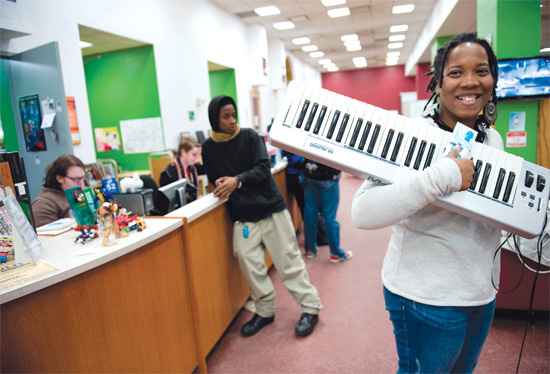
Photographs By Alexander Garcia
In a library?
Why not? “This is what teens want,” says Amy Eshleman, the Chicago Public Library’s assistant commissioner of strategic planning and partnerships. “This is a great example of what learning can look like in an out-of-school environment.” Harris, who read nearly 200 books during the summer and practically lives at YOUmedia, appears to be the program’s poster child. “If I come home late, my mom knows I’ve been one of two places—school or the library,” he says.
The Windy City’s one-of-a-kind program, which attracts young men and women in equal numbers from all over town, has become a national model for libraries of the future. And it’s got support from on high. Barack Obama has not specifically mentioned YOUmedia himself. But a White House statement describing the President’s “Educate to Innovate” campaign (a CEO-led effort to improve dramatically education in science, technology, engineering, and math) prominently mentions the $4 million partnership between the Catherine T. MacArthur Foundation and the Institute of Museum and Library Sciences (IMLS) to fund the creation of as many as 30 YOUmedia centers nationwide over the next three years.
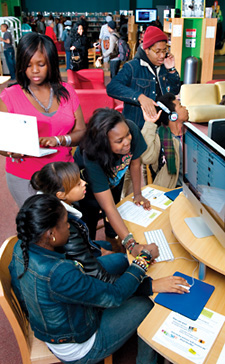 “We want libraries to stay as relevant as they can to their communities,” says Marsha Semmel, IMLS’s former acting director, who’s now its director for strategic partnerships. With 123,000 libraries coast to coast, “I don’t think we’ll be able to fund everyone!” she says. “[But] we’ll push this model out.” The idea is that the new centers—based on the Chicago model—will become places for kids to gather and meet Obama’s stated goal of empowering them to become “makers and creators of things, rather than just consumers.”
“We want libraries to stay as relevant as they can to their communities,” says Marsha Semmel, IMLS’s former acting director, who’s now its director for strategic partnerships. With 123,000 libraries coast to coast, “I don’t think we’ll be able to fund everyone!” she says. “[But] we’ll push this model out.” The idea is that the new centers—based on the Chicago model—will become places for kids to gather and meet Obama’s stated goal of empowering them to become “makers and creators of things, rather than just consumers.”
That already seems to be happening. Kaillif Ammen heard about YOUmedia when some friends said, “Dude, you can play Rock Band at the library!” Since then, the 15-year-old has started coming five days a week, working on recordings, among other things. “Apparently, people started to call me Mr. YOUmedia,” says Ammen, who appears on a public-transit ad for the program.
Creative learning—using digital media and other technology—is the key. “Kids in the United States, they’re falling behind in their knowledge about technology,” explains Semmel. With luck, YOUmedia can help stop the slide. “We’re seeding 25 to 30” new programs, Semmel says of the national effort. “We hope that eventually 1,000 flowers will bloom.”
For the moment, thanks in part to the presence of popular video games like LittleBigPlanet, Mirror’s Edge, and Guitar Hero and easy access to social networking tools such as Facebook, Chicago’s unique space is a hit with the after-school crowd. Since YOUmedia opened in July 2009, about 5,000 teens have taken advantage of the space. (So far, at least, it’s only for high school students—no little kids or adults allowed.) Another big part of the attraction is mentors such as Jabari Mbwelera, the 18-year-old president of YOUmedia Records. (Yes, kids are shown how to make their own studio-quality recordings and music videos.) Traditionally, the library was “not a cool place to be,” says Mbwelera. Now it is. “[Teens] come here with the intention to use the computer, and they find so much more here,” he says.
That “more” includes free digital media workshops where paid teen mentors share the latest scoop on everything from graphic design and digital photography to designing digital games and creating fan fiction and films. Kids can post their work on a closed, online social network called iRemix. There, they can mentor one another and provide peer feedback. They also earn “virtual” currency, which they can use to purchase studio time, headphones, Amazon gift cards, and hard drives from the YOUmedia store. There’s no attendance and no grades. “It’s completely voluntary,” says Taylor Bayless, YOUmedia’s program manager. “Teenagers aren’t getting penalized for not coming.”
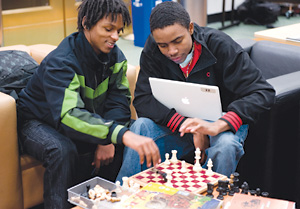 A team from Pittsburgh’s Carnegie Mellon University (CMU) helped with the room’s teen-friendly design, based on research by Mimi Ito, a cultural anthropologist at the University of California at Irvine. The result is a colorful open space with separate areas for “hanging out,” “messing around,” and “geeking out.” Depending on where they’re sitting, teens can socialize, check their Facebook accounts, create a podcast, or attend an author event.
A team from Pittsburgh’s Carnegie Mellon University (CMU) helped with the room’s teen-friendly design, based on research by Mimi Ito, a cultural anthropologist at the University of California at Irvine. The result is a colorful open space with separate areas for “hanging out,” “messing around,” and “geeking out.” Depending on where they’re sitting, teens can socialize, check their Facebook accounts, create a podcast, or attend an author event.
And forget strict rules about putting away electronic devices. “You’re a teen, you’ve got your cell phone on you all the time, you text your friends,” says Drew Davidson, director of Carnegie Mellon University’s entertainment and technology center, who worked on the project. “It’s a low-grade, constant part of your life.” A half dozen young adult mentors help students figure out how to create (and change) content on their computers. Teens need help with things such as, “I want to figure out how to edit this image I have because I want to get my boyfriend out of it,” says Davidson. “You’re not just a consumer of the content.”
Natural colors—green, white, red, blue, and brown—define the different areas. A team worked on what colors “make kids feel more natural and active” but also aren’t too “distracting” for reading and studying, says Eun Jung Lee, a visual designer who led the color effort. The results? Green is the main color, and blue and red are the secondary ones. The “hanging out” area got a cooler, lighter green and blue to make kids feel more energetic, says Lee. The “geeking out” area uses a darker red as the secondary color, since it conveys more of a “calm” feeling that helps with studying and reading.
Not surprisingly, the “messing around” section, where food is welcome, is the most popular. (Teens bring their own munchies since there are no vending machines.) “If you want kids to be here after school, you’re going to lose them the minute they leave to go get a snack,” explains Davidson. He and his team even talked to kids about what kind of furniture they like. Their answers: when they play video games, they like to spread out, low to the ground, and look up at the TV. Done.
Not everything was feasible and affordable. (Even with concessions, the Chicago program’s first year—including the build-out and security—cost $1.2 million. But in the future, library officials expect to spend a third of that amount each year.) Davidson’s crew initially gathered the “pie in the sky, everything you want” version from the kids, he says. “Then we said, ‘Here’s our budget.’” Creating more elaborately themed spaces or even themed ceilings was simply too expensive. Building a more open room was cheaper—and it felt homier, too. Who wouldn’t love the “messing around” middle space, where teens do homework and chat? The center features four PCs and four Macs. There are also 100 laptops that students can check out—but the devices can’t leave the YOUmedia premises. If kids are working on projects, they can take home Flip video cameras and digital cameras.
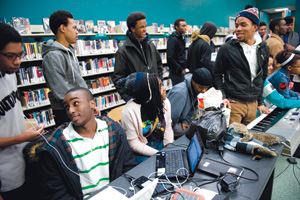 YOUmedia’s primary entrance is off the street, so teens won’t feel as though they’re entering “A Library.” “It makes it feel like it’s theirs,” says Davidson. To get in, students simply show their high school IDs. (College IDs don’t do the trick.) The space is also conveniently positioned by public transit stops for the train and the bus.
YOUmedia’s primary entrance is off the street, so teens won’t feel as though they’re entering “A Library.” “It makes it feel like it’s theirs,” says Davidson. To get in, students simply show their high school IDs. (College IDs don’t do the trick.) The space is also conveniently positioned by public transit stops for the train and the bus.
Often, during their first month or so, teens just hang out, explains Bayless. Then they start to take advantage of the library’s workshops, author events, performances, and materials. “A lot of the kids haven’t used their library cards since they were in elementary school,” says Eshleman. Many kids arrive after school—and stay until the place shuts its doors. They do their regular homework there, too, with the help of teen mentors and, soon, a Chicago Public School teacher who will be on hand.
Typically, teens check out fiction and graphic novels, but they’re encouraged to visit the rest of the building, too. “We don’t want them to forget the vast resources of the library,” says Eshleman. (They like using the vinyl record collection in particular.) Like the library itself, YOUmedia is open seven days a week—Saturdays from 9 a.m. to 5 p.m., Fridays and Sundays from 1 to 5 p.m., and 9 to 9 on the other days. On Tuesdays and Thursdays, Chicago public school students and private- and home-schooled kids visit YOUmedia. Students can participate in YOUmedia’s online community, too, at YouMediaChicago.com, which offers kids an opportunity to share and discuss their ideas and work with adult mentors and other teens.
The history of the project goes back to the MacArthur Foundation’s $8 million “Digital Media and Learning” initiative, launched in 2006 to figure out how digital media is changing the way kids learn, play, and socialize and “to reimagine what learning can look like” in the 21st century, says Connie Yowell, MacArthur’s director of education. To start the process, five years ago the foundation gave a $1.6 million grant to Nicole Pinkard, a visiting associate professor at DePaul University’s College of Computing and Digital Media, to see how digital media affects literacy. She started the Digital Youth Network to help kids from poorer communities.
Foundation officials approached Mary Dempsey, commissioner of the Chicago Public Library, who made the large space at the Harold Washington Library Center available. (Over the years, it had been a coffee shop, a used-book shop, and a storage area.) “This is as big as some small branch libraries,” says Eshleman. It sounds huge, but it represents just an eighth of a floor in the library’s 10-story building. Another sign that it’s in the big city? A security guard stands inside the center at all times.
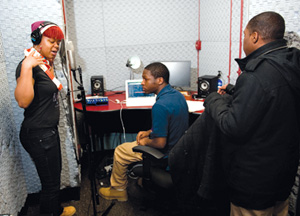 “MacArthur came to us with this research and wanted to create an incubator,” says Eshleman. “We wanted it to be more than just a computer clubhouse. We wanted it to be integrated into our mission.” As a result, the library takes extra steps, such as getting YOUmedia users to participate in the city’s “One Book, One Chicago” program (a decade-old effort to have the entire town read and discuss the same book at the same time). Past titles include Sandra Cisneros’s The House on Mango Street, Colm Tóibín’s Brooklyn, and Toni Morrison’s A Mercy. YOUmedia’s teens not only read the books, they created media projects that supplemented their discussions. (To check out the kids’ imaginative take on Morrison’s book, which even the author has admired, visit http://oboc-amercy.tumblr.com.) And in January, YOUmedia launched the online “YouLit Magazine,” which features teens’ poetry, photography, and fiction and nonfiction works. “We want to be a space of making and doing—adding content,” says Eshleman.
“MacArthur came to us with this research and wanted to create an incubator,” says Eshleman. “We wanted it to be more than just a computer clubhouse. We wanted it to be integrated into our mission.” As a result, the library takes extra steps, such as getting YOUmedia users to participate in the city’s “One Book, One Chicago” program (a decade-old effort to have the entire town read and discuss the same book at the same time). Past titles include Sandra Cisneros’s The House on Mango Street, Colm Tóibín’s Brooklyn, and Toni Morrison’s A Mercy. YOUmedia’s teens not only read the books, they created media projects that supplemented their discussions. (To check out the kids’ imaginative take on Morrison’s book, which even the author has admired, visit http://oboc-amercy.tumblr.com.) And in January, YOUmedia launched the online “YouLit Magazine,” which features teens’ poetry, photography, and fiction and nonfiction works. “We want to be a space of making and doing—adding content,” says Eshleman.
So far, so good. Plus, without any pushing, “kids are now checking out books in greater quantities than they ever have,” says Yowell, and most of those book-toting teens are library newcomers. Last year, YOUmedia circulated an average of 750 print items per month. In addition to reading the center’s books, kids look at its art collection during design workshops. And, as part of “One Book, One Chicago,” they’ve browsed through the library’s special collections.
Libraries that want to get in on the action can submit a grant application this spring. (MacArthur and IMLS have posted a helpful kit on their websites.) And they’re welcome to apply even if they lack a king-size space. No worries. “You can do YOUmedia as long as you have a room, a laptop, a mentor, an interested teenager, and the curriculum,” says Bayless. Each applicant will learn this October or November whether it will get a “learning lab” grant of about $100,000. For now, only libraries that are targeting teens need apply. But, eventually, the program may grow to include centers for younger kids and for adults. “I think it will definitely expand to other ages,” says MacArthur’s Yowell.
In the meantime, YOUmedia will continue to do its thing. And that’s just fine with inventive kids, such as 18-year-old Dimress Dunnigan, a paid intern and mentor: “It’s like a space for us, the creative people, to come here and be creative together.”
Karen Springen teaches journalism at Northwestern University in Evanston, IL
RELATED
The job outlook in 2030: Librarians will be in demand
The job outlook in 2030: Librarians will be in demand
ALREADY A SUBSCRIBER? LOG IN
We are currently offering this content for free. Sign up now to activate your personal profile, where you can save articles for future viewing






Add Comment :-
Be the first reader to comment.
Comment Policy:
Comment should not be empty !!!